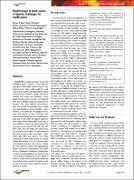| dc.contributor.author | Hsia, Y Renee | |
| dc.contributor.author | Ozgediz, Doruk | |
| dc.contributor.author | Jayaraman, Sudha | |
| dc.contributor.author | Kyamanywa, Patrick | |
| dc.contributor.author | Mutto, Milton | |
| dc.contributor.author | Kobusingye, C Olive | |
| dc.date.accessioned | 2022-04-06T07:19:01Z | |
| dc.date.available | 2022-04-06T07:19:01Z | |
| dc.date.issued | 2011-03-01 | |
| dc.identifier.citation | Hsia, R.Y., Ozgediz, D., Jayaraman, S., Kyamanywa, P., Mutto, M. and Kobusingye, O.C. (2011). Epidemiology of child injuries in Uganda: challenges for health policy. Journal of public health in Africa, 2(1). | en_US |
| dc.identifier.issn | 2038-9922 | |
| dc.identifier.issn | 2038-9930 | |
| dc.identifier.uri | http://hdl.handle.net/20.500.12280/2908 | |
| dc.description.abstract | Globally, 90%ofroad crash deaths occurin the developing world. Children in Africa bear the major part of this burden, with the highest unintentional injury rates in the world. Our study aims to better understand injury patterns among children living in Kampala, Uganda and provide evidence that injuries are significant in child health. Trauma registry records of injured children seen at Mulago Hospital in Kampala were analysed. Data were collected when patients were seen initially and included patient condition, demographics, clinical variables, cause, severity, as measured by the Kampala trauma score, and location of injury. Outcomes were captured on discharge from the casualty department and at two weeks for admitted patients. From August 2004 to August 2005, 872 injuryvisitsforchildren <18 years old were recorded. The mean age was 11 years (95% CI 10.9-11.6); 68% (95% CI 65-72%) were males; 64% were treated in casualty and discharged; 35% were admitted. The most common causes were traffic crashes
(34%), falls (18%) and violence (15%). Most children (87%) were mildly injured; 1% severely injured. By two weeks, 6% of the patients admitted for injuries had died and, of these morbidities, 16% had severe injuries, 63% had moderate injuries and 21% had mild injuries. We concluded that, in Kampala,children bear a large burden of injury from preventable causes. Deaths in low severity patients highlight the need for improvements in facility based care. Further studies are necessary to capture overall child injury mortality and to measure chronic morbidity owing to sequelae of injuries. | en_US |
| dc.language.iso | en | en_US |
| dc.publisher | Page Press Publ | en_US |
| dc.relation.ispartofseries | Journal of public health in Africa;2(1) | |
| dc.subject | Road traffic | en_US |
| dc.subject | Injuries | en_US |
| dc.subject | Developing country | en_US |
| dc.subject | Trauma | en_US |
| dc.title | Epidemiology of Child Injuries in Uganda: Challenges for Health Policy | en_US |
| dc.type | Article | en_US |


